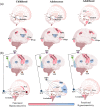Biopsychological correlates of repetitive and restricted behaviors in autism spectrum disorders
- PMID: 34472728
- PMCID: PMC8553330
- DOI: 10.1002/brb3.2341
Biopsychological correlates of repetitive and restricted behaviors in autism spectrum disorders
Abstract
Background: Autism Spectrum Disorder (ASD) is considered a neurodevelopmental condition that is characterized by alterations in social interaction and communication, as well as patterns of restrictive and repetitive behaviors (RRBs). RRBs are defined as broad behaviors that comprise stereotypies, insistence on sameness, and attachment to objects or routines. RRBs can be divided into lower-level behaviors (motor, sensory, and object-manipulation behaviors) and higher-level behaviors (restrictive interests, insistence on sameness, and repetitive language). According to the DSM-5, the grade of severity in ASD partially depends on the frequency of RRBs and their consequences for disrupting the life of patients, affecting their adaptive skills, and increasing the need for parental support.
Methods: We conducted a systematic review to examine the biopsychological correlates of the symptomatic domains of RRBs according to the type of RRBs (lower- or higher-level). We searched for articles from the National Library of Medicine (PubMed) using the terms: autism spectrum disorders, ASD, and autism-related to executive functions, inhibitory control, inflexibility, cognitive flexibility, hyper or hypo connectivity, and behavioral approaches. For describing the pathophysiological mechanism of ASD, we also included animal models and followed PRISMA guidelines.
Results: One hundred and thirty-one articles were analyzed to explain the etiology, continuance, and clinical evolution of these behaviors observed in ASD patients throughout life.
Conclusions: Biopsychological correlates involved in the origin of RRBs include alterations in a) neurotransmission system, b) brain volume, c) inadequate levels of growth factors, d) hypo- or hyper-neural connectivity, e) impairments in behavioral inhibition, cognitive flexibility, and monitoring and f) non-stimulating environments. Understanding these lower- and higher-level of RRBs can help professionals to improve or design novel therapeutic strategies.
Keywords: autism spectrum disorder; neurodevelopmental disorders; repetitive behaviors; restricted behaviors; stereotypes.
© 2021 The Authors. Brain and Behavior published by Wiley Periodicals LLC.
Conflict of interest statement
The authors declare no conflict of interest
Figures



References
-
- Abbott, A. E. , Linke, A. C. , Nair, A. , Jahedi, A. , Alba, L. A. , Keown, C. L. , Fishman, I. , & Müller, R. A. (2018). Repetitive behaviors in autism are linked to imbalance of corticostriatal connectivity: A functional connectivity MRI study. Social Cognitive and Affective Neuroscience, 13, 32–42. 10.1093/scan/nsx129 - DOI - PMC - PubMed
-
- Aida, T. , Yoshida, J. , Nomura, M. , Tanimura, A. , Iino, Y. , Soma, M. , Bai, N. , Ito, Y. , Cui, W. , Aizawa, H. , Yanagisawa, M. , Nagai, T. , Takata, N. , Tanaka, K. F. , Takayanagi, R. , Kano, M. , Götz, M. , Hirase, H. , & Tanaka, K. (2015). Astroglial glutamate transporter deficiency increases synaptic excitability and leads to pathological repetitive behaviors in mice. Neuropsychopharmacology, 40, 1569–1579. 10.1038/npp.2015.26 - DOI - PMC - PubMed
-
- Akkermans, S. E. A. , Rheinheimer, N. , Bruchhage, M. M. K. , Durston, S. , Brandeis, D. , Banaschewski, T. , Boecker‐Schlier, R. , Wolf, I. , Williams, S. C. R. , Buitelaar, J. K. , van Rooij, D. , & Oldehinkel, M. (2019). Frontostriatal functional connectivity correlates with repetitive behaviour across autism spectrum disorder and obsessive‐compulsive disorder. Psychological Medicine, 49, 2247–2255. 10.1017/S0033291718003136 - DOI - PubMed
-
- American Psychiatric Association (2013). Neurodevelopmental Disorders. In American Psychiatric Association (Ed.), Diagnostic and Statistical Manual of Mental Disorders Fifth Edition (DSM‐5). (5th ed., pp. 31–86). Arlington, TX, USA.
Publication types
MeSH terms
LinkOut - more resources
Full Text Sources
Medical

